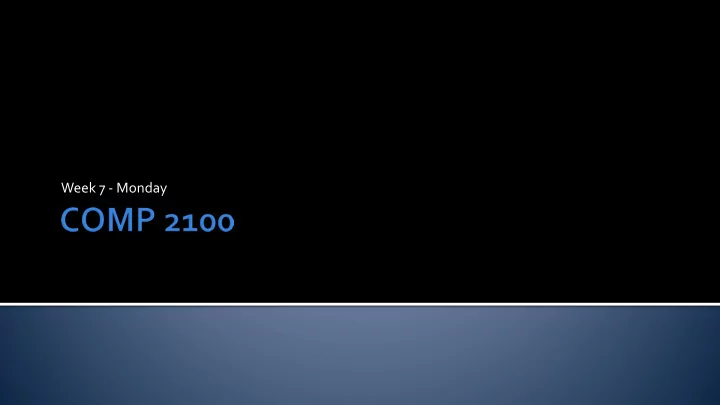

Week 7 - Monday
What did we talk about last time? Binary search trees Implementations Traversals
Infix to Postfix Converter
Visiting every node in a tree is called a traversal There are three traversals that we are interested in today: Preorder Postorder Inorder We'll get to level order traversal in the future
Preorder: Process the node, then recursively process its left subtree, finally recursively process its right subtree NLR Postorder: Recursively process the left subtree, recursively process the right subtree, and finally process the node LRN Inorder: Recursively process the left subtree, process the node, and finally recursively process the right subtree LNR
4 2 5 1 3 6 4 2 1 . . 3 . . 5 . 6 . .
4 2 5 1 3 6 . . 1 . . 3 2 . . . 6 5 4
4 2 5 1 3 6 . 1 . 2 . 3 . 4 . 5 . 6 .
public class Tree { private static class Node { public int key; public Object value; public Node left; public Node right; } private Node root = null; … } The book uses a generic approach, with keys of type Key and values of type Value . The algorithms we'll use are the same, but I use int keys to simplify comparison.
private static void preorder( Node node ) Proxy: public void preorder() { preorder( root ); } Just print out each node (or a dot). Real traversals will actually do something at each node.
private static void inorder( Node node ) Proxy: public void inorder() { inorder( root ); } Just print out each node (or a dot). Real traversals will actually do something at each node.
private static void postorder( Node node ) Proxy: public void postorder() { postorder( root ); } Just print out each node (or a dot). Real traversals will actually do something at each node.
We can take the idea of an inorder traversal and use it to store a range of values into a queue We want to store all values greater than or equal to the min and less than the max private static void getRange( Node node, Queue<Object> queue, int min, int max ) Proxy: public Queue<Object> getRange(int min, int max){ Queue<Object> queue = new ArrayDeque<Object>(); getRange( root, queue, min, max ); return queue; }
private static Node delete(Node node, int key) Proxy: public void delete(int key) { root = delete( root, key ); } Find the node 1. Find its replacement (smallest right child) 2. Swap out the replacement 3. We may need some subroutines: private static Node smallest(Node node, Node parent)
Level-order traversal 2-3 trees Implementing red-black trees Balancing trees by construction
Work on Project 2 Read Section 3.3
Recommend
More recommend